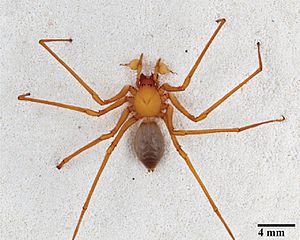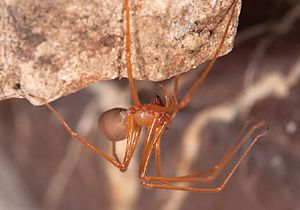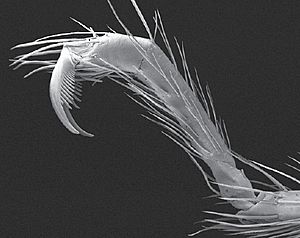Trogloraptor facts for kids
Quick facts for kids Trogloraptor |
|
|---|---|
 |
|
| Male Trogloraptor marchingtoni | |
 |
|
| Female Trogloraptor marchingtoni | |
| Scientific classification |
Trogloraptor is a special type of large spider. It lives deep inside caves in southwestern Oregon, USA. This spider is the only one in its entire spider family, called Trogloraptoridae. There's only one known species, Trogloraptor marchingtoni.
These spiders are mostly yellow-brown. When their legs are stretched out, they can be up to 3 inches (about 7.6 cm) wide. What makes them really unique are the hook-like claws on the very ends of their legs. These claws help them grab things.
Trogloraptor is one of only three new spider families found since 1990. The spider's full name, Trogloraptor marchingtoni, honors Neil Marchington. He is an amateur cave biologist and a deputy sheriff.
Contents
Discovering the Cave Spider
How Trogloraptor Was Found
These amazing spiders were first collected in 2010. They were found by Geo Graening, Neil Marchington, Ron Davis, and Daniel Snyder. These people are cave conservationists who work to protect caves.
Scientists officially described the spiders in 2012. The research team included spider experts Charles Griswold, Tracy Audisio, and Joel Ledford. They all worked at the California Academy of Sciences.
Where the First Spiders Were Found
The first male spider, called the holotype, was found on July 29, 2010. It was in the M2 cave near Grants Pass, Oregon. The first female spider was found later, on September 16, 2010. She was in a cave in Josephine County, Oregon.
Lead researcher Charles Griswold said that Trogloraptor might be the reason for old stories. People in the area used to talk about giant cave spiders. This discovery was very important. Only two other new spider families had been found since 1990. Another spider expert, Norman I. Platnick, said it was as exciting for spider scientists as finding a new dinosaur is for dinosaur scientists.
About the Trogloraptor Family
Its Place in the Spider World
Trogloraptor has only one species, Trogloraptor marchingtoni. It is the only type of spider in its family, Trogloraptoridae. Scientists first thought Trogloraptor was related to a group of spiders called Dysderoidea. These are spiders that have six eyes.
However, Trogloraptor has many special features. For example, its respiratory system (how it breathes) is very old-fashioned. Because of these unique traits, scientists decided it needed its own family. This family likely separated from other spiders about 130 million years ago. This makes it a very old type of spider still living in North America. A study in 2014 looked at the spider's ribosomal DNA. It showed that Trogloraptor is not part of the Dysderoidea group after all.
What Its Name Means
The specific name, marchingtoni, honors Neil Marchington. The genus name Trogloraptor means "cave robber." This name comes from where the spider lives (caves) and its hooked, grabbing legs.
Where Trogloraptor Lives
Its Home in Caves
Scientists found more live Trogloraptor spiders in 2010 and 2011. All of them were deep inside caves in Oregon. Only one young spider was found outside a cave. It was in the understory (the plants growing under the main trees) of an old growth redwood forest in northwest California.
This young spider had different markings than T. marchingtoni. It might be a new species that hasn't been named yet.
Past and Future Homes
The Trogloraptoridae family might have lived in more places long ago. Redwood forests covered a much larger area in North America during the Pliocene epoch. That was about 5 million years ago. It's possible that other species of Trogloraptor are still waiting to be found in other caves.
Physical Description of Trogloraptor
Adult Trogloraptor spiders have six eyes. Males have a body length of about 7 to 10 mm (0.28 to 0.39 inches). Females are a bit larger, from 8 to 10 mm (0.31 to 0.39 inches). When their legs are fully stretched, the spider can reach up to 3 inches (about 7.6 cm) across.
The spider's body is mostly yellow-brown. It has a dark brown V-shape on its cephalothorax (the head and chest part). Its chelicerae (mouthparts) are orange-brown. The abdomen (back part) is purple-brown with some faint, light-colored chevron patterns. The cephalothorax is shaped like a pear, and the sternum (underneath the cephalothorax) is heart-shaped. The abdomen is oval and has a few small bristles. Male spiders have enlarged pedipalps, which are small leg-like parts near their mouth.
The most unique feature of these spiders is their flexible, hooked claws. These are on the very last segments of their legs, called the tarsus. These long claws look like those of spiders in the Gradungulidae family from Australia and New Zealand. However, Trogloraptor is only distantly related to them. Other spiders also have hooked claws, but not as much. These include Doryonychus, Hetrogriffus, and Celaenia.
How Trogloraptor Lives
Hunting and Diet
Trogloraptor spiders make simple webs with only a few strands. They hang these webs from the roofs of caves. Scientists believe their special claws are very important for catching food.
Like the Nelson cave spider from New Zealand (Spelungula cavernicola), Trogloraptor likely hangs upside down from its web. It probably snatches passing flying insects with its claws. However, scientists still don't know exactly what these spiders eat.
Researchers tried to feed captured spiders moths, crickets, and other spiders in the lab. But the Trogloraptor spiders refused to eat and starved after two weeks. This might mean they only eat very specific kinds of prey.
Safety and Behavior
Like most spiders, Trogloraptor has venom glands. But their venom is not known to be harmful to humans. These spiders are also very shy and not aggressive at all. They quickly run away if they see light.


